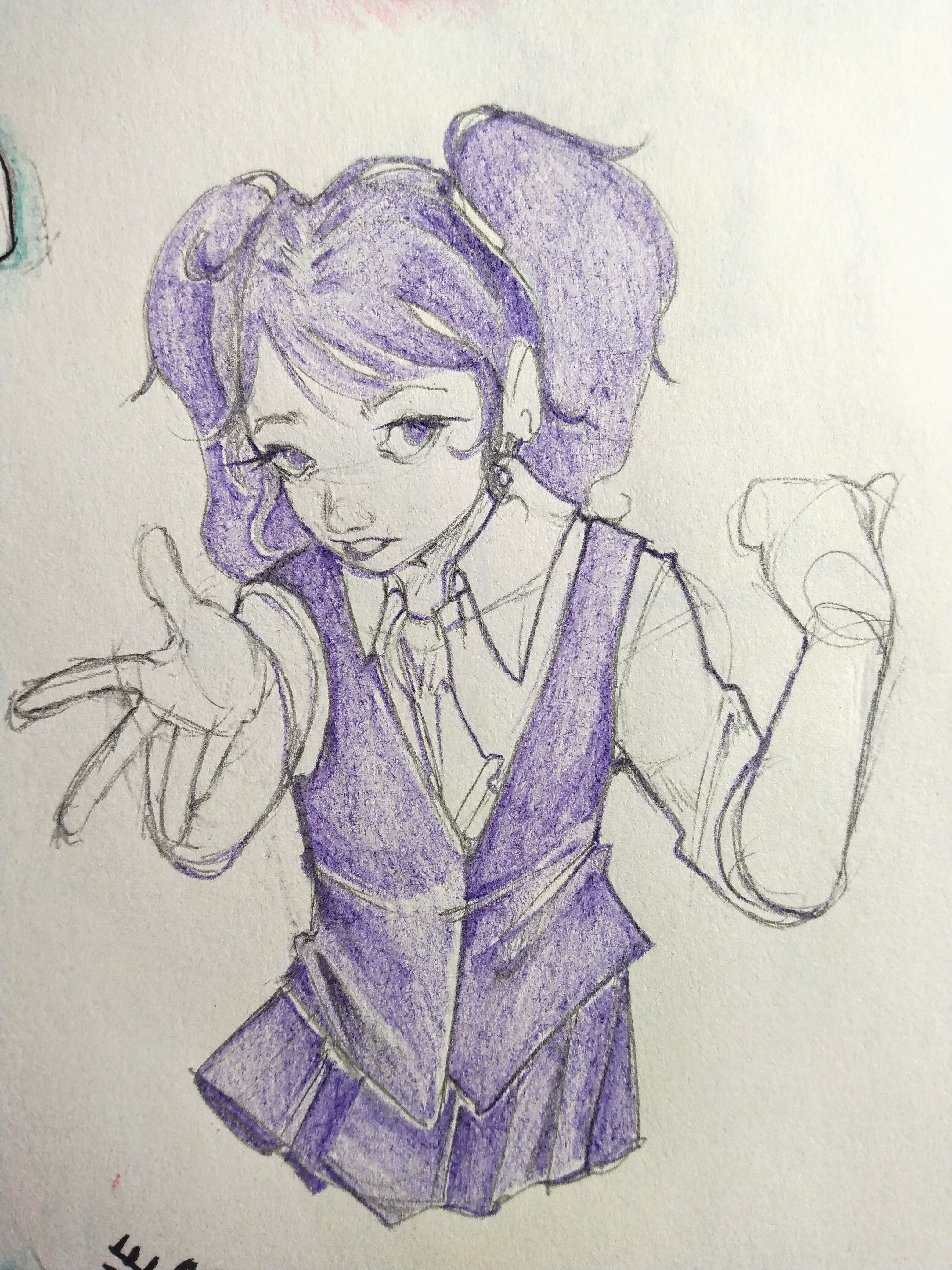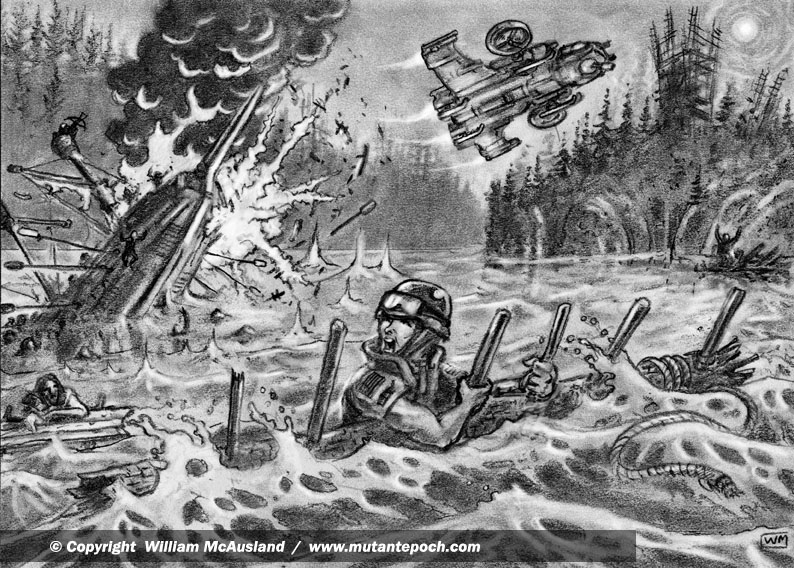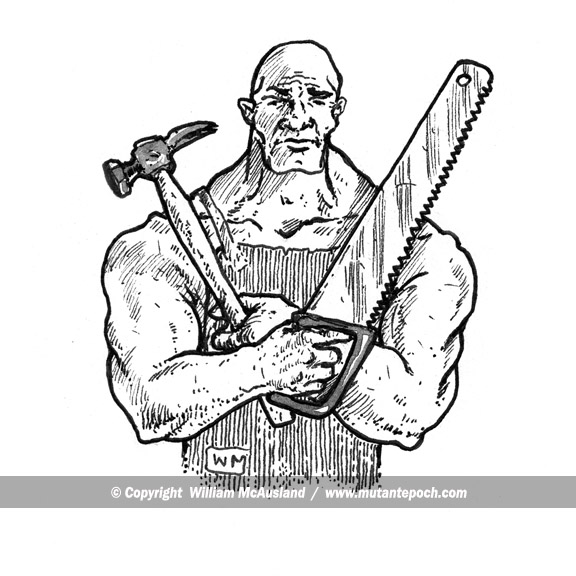The Nerites-class mining barge is the largest type of mining vessel currently in existence. At a length of 1,500 meters, this behemoth houses facilities for processing, refining and purifying most types of ore found on asteroids.
The Nerites incorporates the most advanced technologies developed for mining to date.
The ship’s massive mining turrets comprise two quantum phase modulated (QPM) laser beams on a rotating fixture. These lasers can modulate their wavelength at will, from infrared for melting material, over visible for precision cutting, ultraviolet for surface ablation and breaking down molecular bonds in hard-to-cut materials, to x-ray for fragmenting ultra-dense materials resistent to longer wavelengths, and even gamma rays to break down nuclear bonds of elements impossible to process with other means.
At the center of each mining turret is a tractor beam emitter, used to suck in the material broken off by the lasers.
The ship contains a large hangar housing hundreds of drones, known as the beehive.
Mining drones are used to harvest deposits too small to warrant training the ship’s large mining laser onto. Prospector drones swarm a potential site to detect any relevant ore deposits. Maintainance drones to maintain and repair the ship’s exterior. Tug drones to move the ship’s detachable cargo containers, and possibly damaged drones.
The Nerites-class is controlled by three independent AI cores. One controls the mining and processing of materials, one controls the drones, and one is in charge of ship operations. This advanced system makes it possible for the ship to be operated by a crew as small as 200 individuals.
Armed with 14 medium-class pulse laser turrets (6 at each side, 2 in the back), the Nerites-class is only moderately armed. However, its armor consists of advanced materials and is extremely difficult to crack by anything less than capital-class armaments. In addition, the mining turrets can be used as offense weapons. However, since they are not designed for this purpose, their tracking systems are not fast enough to track anything smaller than large-scale capital ships. Finally, although it is possible to modify some bays within the drone hangar to house combat drones, some miners found ways to add combat protocols to mining drones, making them attach to enemy ships and essentially cutting them to pieces.
The most famous Nerites-class was the Meridian 14, owned by famous explorer Jackson Ives Castle. While many may think that using a mining ship for exploration is strange, Castle once explained that the idea isn’t as far fetched as one may think. The ship has a long range, spacious accomodation, a massive interior that can be converted into mission-specific spaces, advanced sensors and scanners, and it can sustain itself almost indefinitely, as it can mine and process almost any materials required for synthesis. The mining AI was reprogrammed to analyze and collate sensor data instead.
----------
This was a model I created in May 2011 and figured I'd update it.
For more information, please check out the Artstation post:
https://www.artstation.com/artwork/x3ZxEmThe Nerites-class mining barge is the largest type of mining vessel currently in existence. At a length of 1,500 meters, this behemoth houses facilities for processing, refining and purifying most types of ore found on asteroids.
The Nerites incorporates the most advanced technologies developed for mining to date.
The ship’s massive mining turrets comprise two quantum phase modulated (QPM) laser beams on a rotating fixture. These lasers can modulate their wavelength at will, from infrared for melting material, over visible for precision cutting, ultraviolet for surface ablation and breaking down molecular bonds in hard-to-cut materials, to x-ray for fragmenting ultra-dense materials resistent to longer wavelengths, and even gamma rays to break down nuclear bonds of elements impossible to process with other means.
At the center of each mining turret is a tractor beam emitter, used to suck in the material broken off by the lasers.
The ship contains a large hangar housing hundreds of drones, known as the beehive.
Mining drones are used to harvest deposits too small to warrant training the ship’s large mining laser onto. Prospector drones swarm a potential site to detect any relevant ore deposits. Maintainance drones to maintain and repair the ship’s exterior. Tug drones to move the ship’s detachable cargo containers, and possibly damaged drones.
The Nerites-class is controlled by three independent AI cores. One controls the mining and processing of materials, one controls the drones, and one is in charge of ship operations. This advanced system makes it possible for the ship to be operated by a crew as small as 200 individuals.
Armed with 14 medium-class pulse laser turrets (6 at each side, 2 in the back), the Nerites-class is only moderately armed. However, its armor consists of advanced materials and is extremely difficult to crack by anything less than capital-class armaments. In addition, the mining turrets can be used as offense weapons. However, since they are not designed for this purpose, their tracking systems are not fast enough to track anything smaller than large-scale capital ships. Finally, although it is possible to modify some bays within the drone hangar to house combat drones, some miners found ways to add combat protocols to mining drones, making them attach to enemy ships and essentially cutting them to pieces.
The most famous Nerites-class was the Meridian 14, owned by famous explorer Jackson Ives Castle. While many may think that using a mining ship for exploration is strange, Castle once explained that the idea isn’t as far fetched as one may think. The ship has a long range, spacious accomodation, a massive interior that can be converted into mission-specific spaces, advanced sensors and scanners, and it can sustain itself almost indefinitely, as it can mine and process almost any materials required for synthesis. The mining AI was reprogrammed to analyze and collate sensor data instead.
----------
This was a model I created in May 2011 and figured I'd update it.
For more information, please check out the Artstation post: https://www.artstation.com/artwork/x3ZxEm








